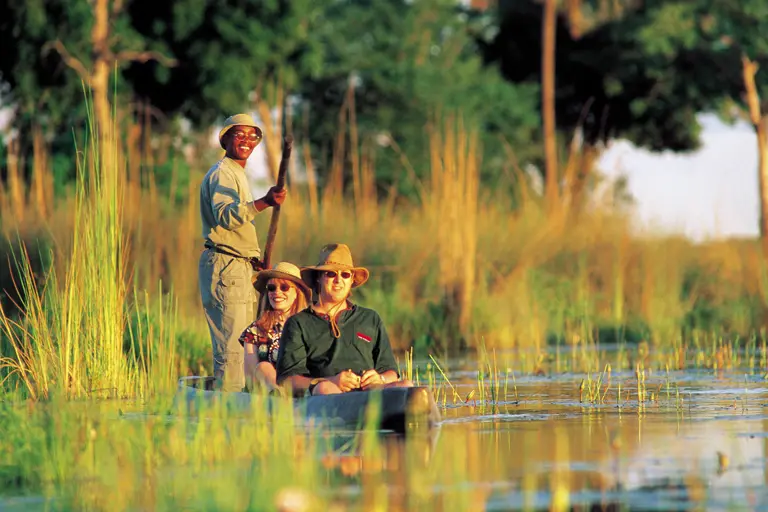





Reasons to Visit Botswana
Wildlife
Unspoilt Wilderness
Unique Delta Environment
Botswana is a landlocked country located in Southern Africa. It shares borders with Namibia, South Africa, Zimbabwe, and Zambia. With a surface area of approximately 581,730 square kilometres, it is roughly the size of France or Texas. The capital city of Botswana is Gabarone. The country has a population of approximately 1.85 million people, with a majority of the population settled in the eastern and south-eastern regions. The official languages are English and Setswana.
Botswana is 84% covered by the Kalahari (Kgalagadi) Desert. The country experiences a variety of vegetation types, ranging from mopane and miombo woodland to teak forests, grasslands, and various acacia woodlands. The landscape also includes floodplains, channels, lagoons, and salt pans.
The climate in Botswana is generally hot and dry. The country has distinct seasons, including a green season from November to March, a mid-season from April to June, and a high/peak season from July to October. Temperatures can reach up to 40 degrees Celsius during the hot summer months.
Botswana is known for its diverse wildlife and is considered a haven for wildlife enthusiasts. The country has set up parks and reserves for the protection of its wildlife.
There is a wealth of animal species, including large mammals such as elephants, rhinos, buffalos, giraffes, and predators like lions, leopards, cheetahs, and hyenas. Botswana is also home to endangered species such as wild dogs, rhinos, pangolins, and aardvarks.
The birdlife in Botswana is impressive, with around 550-590 bird species recorded, including globally threatened species.
The flora of Botswana includes various vegetation types, such as woodlands, forests, grasses, and wetland areas.
Botswana's economy has experienced significant growth since its independence. The discovery of diamonds in 1967 transformed the country from being one of the poorest in the world to one of the wealthiest non-oil producing countries in Africa. In addition to diamonds, Botswana's economy relies on other mineral resources such as copper/nickel, soda ash, and coal. The beef industry and the growing tourism industry are also important economic sectors in Botswana.
The population of Botswana is predominantly composed of the Batswana people, who make up about 78.2% of the population. The Setswana language is widely spoken in the country. The oldest ethnic group in Botswana is the Basarwa, also known as the San people.
Botswana is a multi-party democracy and gained independence on September 30, 1966.
Botswana is known for its traditional cultures and is home to some of the earliest San/Khoisan artefacts with ancient rock paintings.
Botswana offers a range of tourist attractions for nature and wildlife lovers. One of the must-visit places is the Okavango Delta, which is the largest inland delta in the world. Exploring the delta in a mokoro (traditional canoe) while observing the diverse wildlife is a mesmerizing experience.
Other attractions include the Makgadikgadi Pans, known for their vast expanses and zebra migration, the Kalahari Desert with its black-maned lions, and the Chobe/Linyanti regions, which are home to a dense population of elephants.
Botswana also provides opportunities to engage with traditional cultures and experience activities with various cultural groups.
When traveling to Botswana, it is important to consider the climate and the best time to visit based on your preferences. The green season, from November to March, brings higher temperatures and some rainfall. The mid-season, from April to June, offers pleasant temperatures and clear skies. The high/peak season, from July to October, is regarded as the best time for game viewing with drier conditions and wildlife congregating around waterholes.
It is recommended to check your government's travel advisory for up-to-date information on safety, security, health, and local laws and customs.
It is also essential to have comprehensive travel insurance that covers medical emergencies, cancellation, loss, and theft of personal belongings.
When packing for a trip to Botswana, it is advisable to bring neutral-coloured casual clothing suitable for everyday wear. Bright colours and white are not recommended for game viewing. It is essential to pack sturdy shoes or robust trainers with good traction soles for walking in the bush. Depending on the season, pack light jackets or jumpers for summer and warmer jackets for winter. It is also recommended to carry a light spray jacket for traveling between November and April. Other items to consider include thermal underwear for cold nights, sunscreen, hats, and insect repellent.
If self-driving, remember to bring your driving license, preferably in English or an international license.
The electricity voltage in Botswana is 230 volts, and the frequency is 50 Hz. Botswana uses a mix of Type G and M electrical outlets. Type G outlets have three rectangular pins whereas Type M have 3 round pins. If your electrical appliances use a different type of plug, you will need a plug adapter. Additionally, some appliances may require a voltage converter or transformer to ensure compatibility with Botswana's electrical system.
As part of the terms and conditions for Chameleon Holidays and Travel, it is essential for all clients to purchase comprehensive travel insurance. The insurance should include full medical cover, including emergency repatriation, as well as coverage for cancellation, loss, damage, and theft of personal luggage and belongings. It is crucial to arrange appropriate insurance and carry the insurance details with you at all times during your trip. Chameleon recommends using reputable travel insurance providers such as World Nomads.
